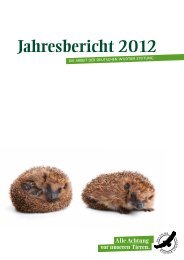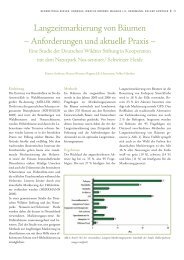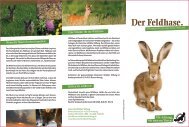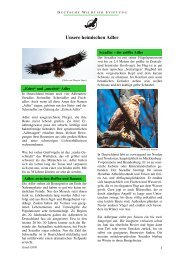Zur Biologie und Ökologie des Feldhasen - Deutsche Wildtier Stiftung
Zur Biologie und Ökologie des Feldhasen - Deutsche Wildtier Stiftung
Zur Biologie und Ökologie des Feldhasen - Deutsche Wildtier Stiftung
Erfolgreiche ePaper selbst erstellen
Machen Sie aus Ihren PDF Publikationen ein blätterbares Flipbook mit unserer einzigartigen Google optimierten e-Paper Software.
PFISTER, H., KOHLI, L., KÄSTLI, P., BIRRER, S. (2002): Feldhase. Schlußbericht 1991-2000. B<strong>und</strong>esamt für Umwelt, Wald <strong>und</strong><br />
Landschaft, BUWAL (Hrsg.). Schriftenreihe Umwelt Nr. 334. Bern, Schweiz.: 150 S.<br />
PIELOWSKI, Z. (1962): Über ökologische Forschungen am <strong>Feldhasen</strong> in Polen. Beitr. Jagd u. Wildf. 2: 41-52.<br />
PIELOWSKI, Z. (1966): Forschungen über den <strong>Feldhasen</strong>: XII Die Raumstruktur der Population. 9 (22): 449-484.<br />
PIELOWSKI, Z. (1968): Die Jahresbilanz einer Hasenpopulation in Polen. Beitr. Jagd u. Wildf. 6: 129-137.<br />
PIELOWSKI, Z. (1971): Studies on the European hare. XXV. The individual growth curve of the hare. Acta Theriologica 16:<br />
79-88.<br />
PIELOWSKI, Z. (1972): Studies on the European hare. XXIX. Home range and degree of ersidence of the european hare. Acta<br />
Theriologica 17(9): 93-103.<br />
PIELOWSKI, Z. (1976a): Number of young born and dynamics of the european hare population. In: PIELOWSKI, Z., PUCEK, Z.<br />
(Hrsg.): Ecology and Management of European Hare Populations. Warszawa: 75-78.<br />
PIELOWSKI, Z. (1976b): The role of foxes in the reduction of the European hare population. In: PIELOWSKI, Z., PUCEK, Z.<br />
(Hrsg.): Ecology and Management of European Hare Populations. Warszawa: 135-148.<br />
PIELOWSKI, Z. (1991): Über die Abhängigkeit der Besatzdichte <strong>und</strong> anderer Populationsparameter <strong>des</strong> Hasen von der<br />
Agrarstruktur <strong>und</strong> landwirtschaftlichen Aktivitäten. Beitr. Jagd u. Wildf. 17: 147-156.<br />
PILARSKA, J. (1969): Individual growth curve and food consumption by European hare (Lepus europaeus PALLAS 1778) in<br />
laboratory conditions. Bulletin de I'Académie Polonaise <strong>des</strong> Sciences Série <strong>des</strong> Sciences Biologique 17: 299-305.<br />
PLAUT, I., BORUT, A., SPIRA, M.E. (1996): Effects of various environmental conditions on growth and reproduction of the sea<br />
hare Aplysia oculifera (Adams and Reeve, 1850). Journal of Comparative Physiology B - Biochemical Systemic and<br />
Environmental Physiology 166: 510-516.<br />
PLIKAT, K. (1991): H<strong>und</strong>ert Jahre Hasenjagd auf Langeoog. Wild <strong>und</strong> H<strong>und</strong> 94 (1): 8-10.<br />
POLLEY, R. W., THOMAS, M.R., SLOUGH, J.E., BRADSHAW, N.J. (1993): Surveys of Diseases of Winter Barley in England and<br />
Wales, 1981-1991. Annals of Applied Biology 123: 287-307.<br />
PSIKAL, I., SMID, B., KUBALIKOVA, R., VALICEK, L., RODAK, L., KOSINOVA, E. (1997): Colorimetric detection of lagomorphs'<br />
calicivirus genomic sequences by polymerase chain reaction incorporating digoxigenin dUTP. Veterinary Microbiology<br />
57: 55-67.<br />
PUCEK, Z., LOWE, V. P. W. (1975): Age criteria in small mammal populations. In: GOOLEY, F. B., PETRUSEWICZ, K.,<br />
RYSZKOWSKI, L. (Hrsg). Small mammals - their productivity and population dynamics. Cambridge, London, New York,<br />
Melbourne.: 55-72.<br />
PUPPE, K. (1966): Untersuchungen über die Variationsbreite <strong>des</strong> nutzbaren Zuwachses <strong>des</strong> Hasen in Abhängigkeit von<br />
regionalen Klimaunterschieden. Beitr. Jagd u. Wildf. 5: 109-117.<br />
REITZ, F., LEONARD, Y. (1994): Characteristics of European hare Lepus europaeus use of space in a French agricultural<br />
region of intensive farming. Acta Theriologica 39 (2): 143-147.<br />
RIECK, W. (1956): Untersuchungen über die Vermehrung <strong>des</strong> <strong>Feldhasen</strong>. 2. Paul Parey. Hamburg.: 49 - 90.<br />
RIECK, W. (1962): Analyse der <strong>Feldhasen</strong>strecke nach dem Gewicht der Augenlinse. Suppl. Rich. Zool. Appl. Caccia 4: 21-<br />
29.<br />
RIECK, W. (1966): Zuwachs <strong>und</strong> Abschuß beim Hasenbesatz <strong>des</strong> Reviers Bibesheim a. Rh. Beitr. Jagd u. Wildf. 5: 95-98.<br />
RIECK, W. (1977): Der Feldhase. DJV Niederwildausschuß. <strong>Deutsche</strong>r Jagdschutzverband e.V. Merkblatt Nr. 4. Bonn.: 37 S.<br />
RIGA, F., TROCCHI, V., RANDI, E., TOSO, S. (2001): Morphometric differentiation between the Italian hare (Lepus corsicanus<br />
De Winton, 1898) and the European brown hare (Lepus europaeus PALLAS, 1778). Journal of Zoology 253: 241-252.<br />
RIMATHÉ, R. (1977): <strong>Zur</strong> saisonalen Ab<strong>und</strong>anzdynamik <strong>des</strong> <strong>Feldhasen</strong> (Lepus europaeus PALLAS) im Schweizerischen<br />
Mittelland. Diss. thesis. Philosophische Fakultät d. Univ. Zürich: 176 S.<br />
RIZZOTTO, M., FOCARDI, S. (1997): A physiologically-based model of a self-motivated hare in relation to its ecology.<br />
Ecological Modelling 95: 191-209.<br />
ROSELL, F. (2001): Effectiveness of predator odors as gray squirrel repellents. Journal of Zoology 79: 1719-1723.<br />
RÜHE, F. (1999): Effect of stand structures in arable crops on brown hare (Lepus europaeus) distribution. Gibier Faune<br />
Sauvage, Game Wildl. Vol. 16 (4): 317 - 337.<br />
RÜHE, F. (2001): "Zu eng!". Ndrs. Jäger 4: 12-15.<br />
RUSSELL, J.E., TUMLISON, R. (1996): Comparison of microstructure of white winter fur and brown summer fur of some arctic<br />
mammals. Acta Zoologica 77 77,4. Pergamon-Elsevier Science Ltd, The Boulevard, Langford Lane, Kidlington, Oxford,<br />
England OX5 1GB.: 279-282.<br />
87








